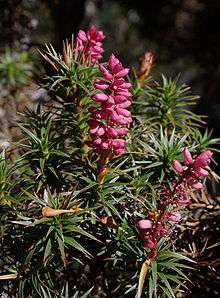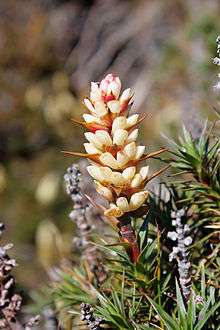Richea scoparia
Richea scoparia (formerly known as R. angustifolia), is a wide spread Tasmanian endemic plant. The genus Richea, forms part of the Ericaceae (formerly Epacridaceae) family, which are commonly heath-like shrubs.[3][4] The name refers to the erect bushy growth habit, described as a broom-like shrub, most commonly referred to as the honey bush or simply ‘scoparia’ to many bushwalkers.[5]
| Richea scoparia | |
|---|---|
 | |
| Richea scoparia flowering in Mount Field National Park, Tasmania | |
| Scientific classification | |
| Kingdom: | Plantae |
| Clade: | Tracheophytes |
| Clade: | Angiosperms |
| Clade: | Eudicots |
| Clade: | Asterids |
| Order: | Ericales |
| Family: | Ericaceae |
| Genus: | Richea |
| Species: | R. scoparia |
| Binomial name | |
| Richea scoparia | |
| Synonyms | |
|
Richea angustifolia | |
Description
Richea scoparia is 1-3m high and commonly grows in wind-swept regions of mountains. The leave persist for a number of years, even when dead. Leaves are crowded, sharp pointed, linear-lanceolate with a broad sheathing base, 3-6cm long.[3][6] Inflorescences are terminal spikes 4-12cm in varying colours of orange, yellow, red, pink or white, flowering in January- March. Flowers with caps of joined petals, which a deciduous, exposing 5mm long stamens and a short style.[6][3]
Hybrid
Richea scoparia forms a hybrid species with Richea pandanifolia. The hybrid species, Richea curtisiae is relatively common where both R. scoparia and R. pandanifolia occur, especially after a disturbance as a result of fire or a clearing.[7]
Distribution
Richea scoparia is found in montane vegetation and is subject to harsh conditions throughout several months of the year. It occurs in the west, south-west, north-east and Central Plateau of Tasmania[4] in a variety of habitats above 700m. It is widespread in alpine regions and associated with a number of varying species.[7] R. scoparia is a slow growing, scleromorphic, perennial species with many morphological variabilities.[8] The growth habits and morphology of R. scoparia populations are influenced by the level of difference weather conditions, to which each population is exposed.[4] The exposure to wind speed and direction have a predominant effect on growth rate and success of the species,[9][8] which grows as a dense rounded bush in highly exposed areas.[6]
Reproduction
Richea scoparia and Niveoscincus microlepidotus (snow skink) form a unique interaction, where N. microlepidotus aids in the pollination of R. scoparia by removing the calyptra (fused petal caps) of the inflorescence to feed on the nectar of the plant.[10] This exposes the reproductive parts which increases the number of seeds dispersed and pollination success of the plant. This interaction has been thought to have been an adaptation to the harsh weather conditions by evolving with the lizards feeding habits to ensure the success of calyptra removal and dispersal of seeds.[10]
References

- "Richea scoparia". Australian Plant Name Index (APNI), IBIS database. Centre for Plant Biodiversity Research, Australian Government.
- Hooker, J.D. in Hooker, W.J. (1847). "Florae Tasmaniae Spicilegium: or, Contributions towards a Flora of Van Diemen's Land". London Journal of Botany. 6: 273.CS1 maint: multiple names: authors list (link)
- Curtis, Winifred M., 1905- (1963). The student's flora of Tasmania. OCLC 770925389.CS1 maint: multiple names: authors list (link)
- Menadue, Y; Crowden, RK (1983). "Morphological and chemical variation in populations of Richea scoparia and R. angustifolia (Epacridaceae)". Australian Journal of Botany. 31 (1): 73. doi:10.1071/bt9830073. ISSN 0067-1924.
- Wapstra, Mark. (2010). Tasmanian plant names unravelled. Fullers Bookshop. ISBN 978-0-9804720-2-8. OCLC 681305362.
- Launceston Field Naturalists Club (2008). A Guide to Flowers & Plants of Tasmania. Launceston: Reed New Holland. p. 30.
- Menadue, Yvonne; Crowden, R. K. (2000). "Taxonomic revision of Richea R.Br. (Epacridaceae)". Australian Systematic Botany. 13 (5): 773. doi:10.1071/sb99028. ISSN 1030-1887.
- Morgan, Sam W.; Kirkpatrick, James B.; di Folco, Maj-Britt (May 2010). "Wind-controlled linear patterning and cyclic succession in TasmanianSphagnummires". Journal of Ecology. 98 (3): 583–591. doi:10.1111/j.1365-2745.2009.01637.x. ISSN 0022-0477.
- Lynch, AJJ; Kirkpatrick, JB (1995). "Pattern and Process in Alpine Vegetation and Landforms at Hill One, Southern Range, Tasmania". Australian Journal of Botany. 43 (6): 537. doi:10.1071/bt9950537. ISSN 0067-1924.
- OLSSON, MATS; SHINE, RICHARD; BA'K-OLSSON, ELISABETH (October 2000). "Lizards as a plant's 'hired help': letting pollinators in and seeds out". Biological Journal of the Linnean Society. 71 (2): 191–202. doi:10.1111/j.1095-8312.2000.tb01253.x. ISSN 0024-4066.
| Wikimedia Commons has media related to Richea scoparia. |